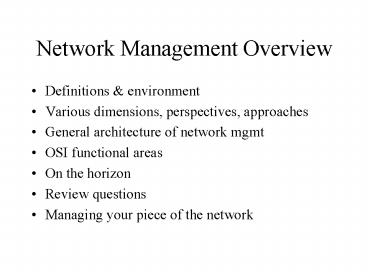Network Management Overview - PowerPoint PPT Presentation
1 / 19
Title:
Network Management Overview
Description:
'In general, network management is a service that employs a number of tools, ... Router (possibly with firewalling, load balancing . . .) PC/workstation ... – PowerPoint PPT presentation
Number of Views:21
Avg rating:3.0/5.0
Title: Network Management Overview
1
Network Management Overview
- Definitions environment
- Various dimensions, perspectives, approaches
- General architecture of network mgmt
- OSI functional areas
- On the horizon
- Review questions
- Managing your piece of the network
2
Network Management Definition 1
- In general, network management is a service that
employs a number of tools, applications, and
devices to assist human network managers in
monitoring and maintaining networks. - Cisco Network Management Basics
3
Network Management Definition 2
- Intuitively, network management encompasses
tasks associated with planning, deploying,
configuring, operating, monitoring, tuning,
repairing, and changing computer networks. - Comer
4
Modern networked systems have
- Many autonomous but cooperating systems
- Heterogeneity (variety of system types, OSes,
protocols, etc.) - Both physical and logical structures
- An essential role in modern business
5
Non-technical management dimensions
- Business type/needs
- Public/private, internet/Internet/extranet,
e-commerce or not, real-time or not . . . - Cost/benefit analyses
- Capital budgeting/investment
- Change management (this is not configuration
management!)
6
Technical management dimensions
- Network types
- LAN, MAN, WAN, VPN, Internet . . .
- Functional areas
- Fault, configuration, accounting, performance,
security . . . - Stages
- Planning, installation, operation, change . . .
- Disciplinesmanagement of
- Network, system, information, application,
enterprise . . . - Information types
- Data, voice, video, multimedia . . .
7
Traditionally distinct
- Applications management
- Transactions processed, reports produced
- Information management
- Records retrieved, tables joined . . .
- Systems management
- End system/OS-dependentCPU cycles, memory . . .
- Network management
- Communications resourceslines, switches, packets
8
(No Transcript)
9
A managed device can be
- Switch (Ethernet, VLAN-capable . . .)
- Router (possibly with firewalling, load balancing
. . .) - PC/workstation
- Server (file, DNS, DHCP, Web . . .)
- Printer (or any other input/output device)
- Wireless access point
- Consumer broadband endpoint (Cable/DSL modem)
- Any device that send, receives, or forwards data
and can provide information about its data flow - (In practice, anything that can run an SNMP agent
or can be otherwise monitored and controlled)
10
Element versus network management
- We strive for network management
- Vendors often provide element management
- Overall network management is difficult
- Implementing simple functionality on a single
device is easier - Proprietary solutions often dont work in
heterogeneous environments
11
Note that we usually do not directly observe or
measure traffic on a network! But . . .
- We can ask devices what they have been doing
- Polling ad-hoc, scheduled, and demand-based
- We can tell devices to notify us when something
unusual is detected - Traps send when pre-specified conditions occur
- We can place special data collection devices on
the network - Probes dedicated hardware, a PC with special
software, even a hub or switch put there for
management purposes
12
OSI net mgmt model FCAPS
- Fault
- detect, log, isolate, notify affected parties of,
and fix problems - Configuration
- retrieve and set operational parameters
- Accounting
- promote efficient use, control, and chargeback
- Performance
- gather data, construct baselines, and detect
deviations from baselines - Security
- identify sensitive resources map users to
resources appropriately
13
To start you thinking . . .
- (Fault mgmt) Why is fixing a fault often not your
first priority? - (Config. mgmt) Whats necessary to configure many
heterogeneous devices at once? - (Accounting mgmt) Is accounting importance
different on a LAN versus a WAN? - (Perf. mgmt) Whats the ultimate perf. mgmt goal?
Line utilization ? Something else? - (Sec. mgmt) Whats the ultimate sec. mgmt goal?
Minimize break-ins? Other?
14
Approaches related to net mgmt
- SNMP Simple Network Management Protocol
- CMIP Common Management Information Protocol
- DMTF Desktop Management Task Force
- TMN Telecommunications Management Network
- WBEM Web-Based Enterprise Management
- JMX Java Management Extensions
- DCE Distributed Computing Environment extensions
- CORBA Common Object Request Broker Architecture
extensions - ODP Open Distributed Processing extensions
- XML-based approaches
15
The Preferred Perspective of this Class to
Network Management (SHOPS)
- Scalable (to tens of thousands of nodes if
necessary or desirable) - Heterogeneous (many devices, OSes, etc.)
- Open-systems oriented (not proprietary NOS
oriented) - Programmable/scriptable (for automation of
management functions) - Standards-based (e.g., SNMP)
Notethis addresses Comers point that manual
network management is slow and inconsistent
16
Notable trends
- Continuing integration of data, voice, multimedia
- More sensitivity to Q of S, security, mobility,
globalization - Peer-to-peer information sharing
- Metacomputing (distributed, virtual computing
structures, including virtual servers, systems,
networks, and grid computing) - Network service providers, delegated/outsourced
network management . . . - Transitioning from manual to automated network
management (Comer emphasis)
17
Question
- An unauthorized application is consuming 60 of
our Internet bandwidth. We can control it with
an initial investment of 5,000 plus an
additional 1,000 per month. Should we control
it?
18
Always keep in mind . . .
- If the management functionality does not
directly or indirectly solve a business problem,
it is totally useless . . . - Network ManagementWhat it is and what it
isntStevenson 1995
19
Hands-On Preview When you manage a network
device, you will do these things
- Establish management communication
- Establish network connectivity
- Do initial configuration
- Configure SNMP agent for polling
- Poll from a management station
- Configure SNMP agent for test traps
- Receive traps at a management station
- Analyze data and set baseline parameters
- Adjust trap settings
- Refine and enhance configuration, data
collection, analysis . . .
Document everything throughout!































